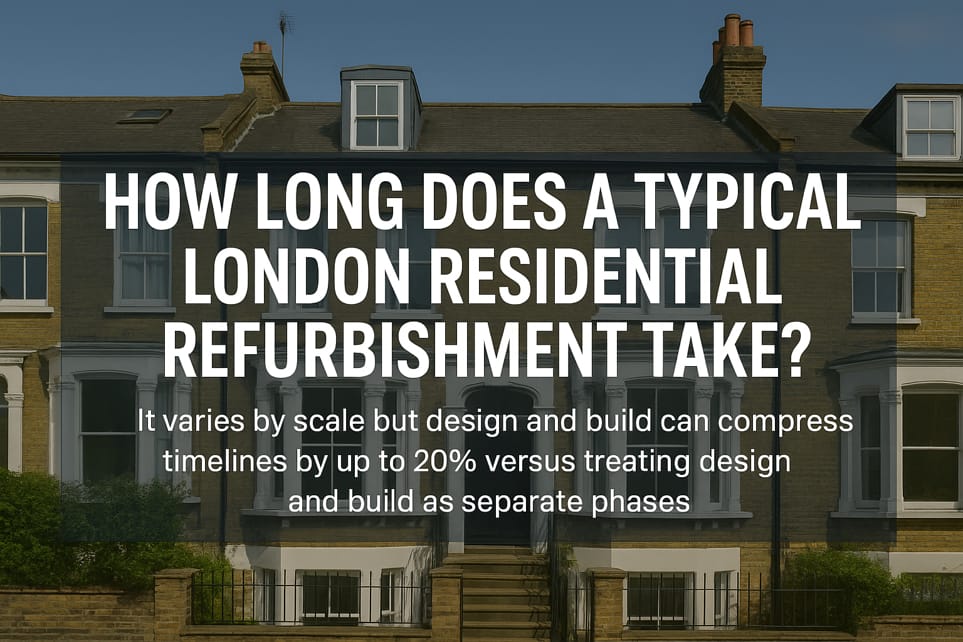
How Long Does a Typical London Residential Refurbishment Take?
Residential refurbishment in London has grown significantly in demand over the past decade. Homeowners are investing in updating their properties to suit modern lifestyles, increase property value, or optimise small spaces. A residential refurbishment involves upgrading kitchens, bathrooms, living areas, bedrooms, and sometimes the exterior of the property. The time it takes depends on project scale, design complexity, and planning permissions.
London’s diverse property stock—from Victorian terraces to modern apartments—creates unique challenges for refurbishments. Renovation timelines vary, and homeowners often ask how long projects will last and what factors affect schedules. With the right team of architects, builders, and project managers, residential refurbishments can be delivered efficiently, meeting both budget and lifestyle needs.
Key Takeaways
-
Typical residential refurbishment projects in London range from a few weeks to several months.
-
Project duration depends on property size, scope, and design complexity.
-
Planning permission and building regulation approvals can extend timelines.
-
Working with architects and professional contractors reduces delays and ensures quality.
-
Proper preparation, clear schedules, and material selection significantly influence completion times.
-
Unexpected issues, such as structural repairs or hidden faults, may lengthen refurbishment timelines.
-
Open communication with contractors helps manage expectations and keeps projects on track.
Factors Affecting Residential Refurbishment Timelines
Residential refurbishment duration depends on several key factors. Each project has unique challenges that influence the timeline.
1. Project Scope
The project scope is one of the biggest determinants of duration. Small refurbishments, like updating a kitchen or bathroom, may take a few weeks, whereas full-home renovations can last several months.
Examples:
-
Single-room refurbishments: 2–6 weeks
-
Multiple rooms or floor renovations: 3–6 months
-
Full-property refurbishments: 6–12 months
Clearly defining the scope early helps set realistic timelines and budgets.
2. Property Size and Type
London properties vary widely in size and construction style. A one-bedroom apartment in a modern block may be simpler to refurbish than a Victorian townhouse with structural challenges.
Influences include:
-
Age of property: Older properties often need additional repairs.
-
Property layout: Open-plan spaces may require structural adjustments.
-
Building materials: Original construction materials can affect the pace of renovations.
3. Planning Permission and Building Regulations
Some refurbishment projects in London require planning permission, especially when extending or altering the structure.
Key points:
-
Minor refurbishments often do not require permission.
-
Structural changes or extensions need approval, which can add weeks or months.
-
Building regulations ensure safety, energy efficiency, and compliance.
Delays in approvals can extend project timelines, so early submission is essential.
4. Design Complexity
The more complex the design, the longer the refurbishment takes. Bespoke cabinetry, intricate tiling, or high-end finishes require more time and skilled labour.
Examples:
-
Simple repainting or flooring installation: Short turnaround
-
Bespoke kitchens or bathrooms: Longer due to custom fabrication and installation
-
Smart home systems integration: Adds technical installation time
5. Contractor Availability and Coordination
London’s construction market can be busy, affecting labour availability.
-
Booking reputable contractors may require early scheduling.
-
Multiple trades must be coordinated: electricians, plumbers, carpenters, painters.
-
Delays in one trade can impact the overall timeline.
Professional project management helps coordinate teams efficiently, keeping projects on schedule.
Typical Timeline for a Residential Refurbishment
Although timelines vary, a typical residential refurbishment follows several stages:
1. Initial Planning and Design (2–4 weeks)
During this stage, architects or designers work with homeowners to define the project. Tasks include:
-
Assessing existing conditions
-
Producing drawings and floor plans
-
Selecting materials and finishes
-
Preparing cost estimates
2. Planning Permission and Approvals (2–8 weeks or longer)
If structural changes or extensions are included, planning permission may be required.
-
Minor alterations often fall under permitted development rights.
-
Major structural work requires council approval.
-
Building regulations approvals ensure safety and compliance.
3. Preparation and Demolition (1–3 weeks)
This stage involves clearing the space, removing old fixtures, and preparing for construction.
-
Kitchen or bathroom strip-outs
-
Removing flooring or wall coverings
-
Temporary relocation of residents or furniture
4. Structural Work and Extensions (2–8 weeks)
If the refurbishment involves structural changes, such as removing walls or extending the property, this phase can be time-consuming.
-
Reinforcing beams and foundations
-
Constructing new walls or partitions
-
Installing windows, doors, and roof changes
5. Mechanical, Electrical, and Plumbing Work (1–3 weeks)
Modern refurbishments often include updated systems.
-
Installing heating, plumbing, and electrical wiring
-
Integrating smart home systems
-
Ensuring compliance with building regulations
6. Finishes and Interior Fit-Out (3–8 weeks)
After structural and technical work, the focus shifts to aesthetics and functionality.
-
Painting and decorating
-
Flooring installation
-
Kitchen and bathroom fit-out
-
Lighting and fixture installation
7. Final Inspections and Handover (1 week)
Before moving in, inspections ensure work meets standards:
-
Building regulation compliance checks
-
Snagging to identify minor defects
-
Final approvals from contractors and local authorities
Tips for Reducing Refurbishment Timelines
Homeowners can actively manage refurbishment schedules with these strategies:
-
Clear Project Scope: Define goals and limits to avoid unnecessary delays.
-
Hire Experienced Professionals: Architects and project managers coordinate trades efficiently.
-
Choose Off-the-Shelf Materials: Custom items take longer to fabricate and deliver.
-
Early Permissions: Submit planning and building applications at the start.
-
Regular Communication: Hold weekly updates with contractors to prevent surprises.
-
Plan for Contingencies: Allocate extra time for unexpected issues like hidden damp or outdated wiring.
Unexpected Delays in London Refurbishments
Even with careful planning, delays can occur:
-
Hidden Structural Problems: Older properties may have rot, subsidence, or weak foundations.
-
Material Shortages: London refurbishment projects often face delivery delays for tiles, cabinetry, or plumbing items.
-
Weather Impacts: Heavy rain or cold can slow external work.
-
Coordination Issues: Miscommunication between trades can extend timelines.
Allowing a buffer of 10–20% of total time ensures realistic expectations.
Advantages of Planning Refurbishments in Phases
Large refurbishments often benefit from a phased approach:
-
Phase 1 – Essential Structural Work: Focus on safety, walls, foundations, and roofing.
-
Phase 2 – Systems Upgrade: Plumbing, heating, electrical, and ventilation.
-
Phase 3 – Finishes: Flooring, painting, kitchens, bathrooms, and fittings.
Phasing allows parts of the property to remain functional and reduces overall disruption.
Residential Refurbishment Cost vs. Time
Time and cost are closely linked:
-
Longer projects generally cost more due to labour, materials, and living arrangements.
-
Efficient planning reduces unnecessary work and keeps the budget on track.
-
Early design decisions prevent costly last-minute changes.
Homeowners who plan carefully save both money and time.
Working with Architects in London
Architects play a key role in efficient residential refurbishments:
-
Drafting accurate plans that consider existing structures
-
Advising on building regulations and planning approvals
-
Selecting materials and layouts that minimise construction delays
-
Coordinating contractors and schedules for timely completion
Experienced London architects ensure that refurbishment projects finish on schedule while achieving high-quality results.
Final Thoughts on Residential Refurbishment Timelines
London residential refurbishments vary widely in duration. Small projects may take weeks, while full renovations can last months. Factors influencing timelines include project scope, property type, design complexity, planning approvals, and contractor coordination. Homeowners can optimise schedules by hiring experienced architects, defining clear goals, and allowing contingency time.
By partnering with Studio 20 Architects, homeowners can streamline the refurbishment process—from concept and design to completion—ensuring projects are delivered on time and to the highest standard.
Frequently Asked Questions (FAQs)
1. How long does a small residential refurbishment take in London?
Small refurbishments, such as a single kitchen or bathroom, typically take 2–6 weeks, depending on materials and contractor availability.
2. How long does a full house refurbishment take?
Full-property refurbishments can last 6–12 months, factoring in structural work, planning permission, and interior fit-outs.
3. Can refurbishment timelines be shortened?
Yes. Clear planning, off-the-shelf materials, and experienced contractors can reduce timelines. However, rushing structural or regulatory steps is not recommended.
4. Do older properties take longer to refurbish?
Often yes. Victorian or Edwardian properties may require additional structural repairs, plumbing, or wiring updates, adding weeks or months.
5. Should I hire an architect for my refurbishment?
Yes. Architects coordinate design, planning, and construction, which saves time, avoids errors, and improves final results.




